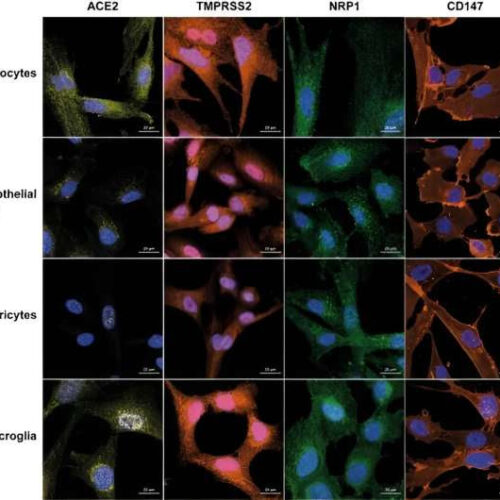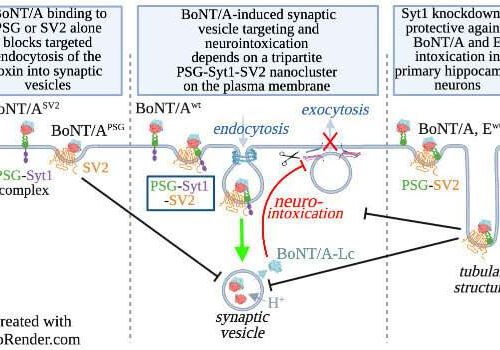by Aswathy Ammothumkandy, Charles Liu and Michael A. Bonaguidi, The Conversation Credit: Pixabay/CC0 Public Domain Your brain can still make new neurons when you’re an adult. But how does the rare birth of these new neurons contribute to cognitive function? Neurons are the cells that govern brain function, and you are born with most of the neurons...
Tag: <span>brain cells</span>
Q&A: How a ‘switchable’ CAR-T therapy sets its sights on deadly brain cancer
by Laura López González, University of California, San Francisco Killer T cells (green and red) surround a cancer cell (blue, center). Credit: NIH UC San Francisco treated its first brain cancer patient with an experimental new CAR-T therapy discovered and manufactured at the university earlier this year. The treatment, known as E-SYNC, is a form of...
Reprogramming brain cells into neurons: New findings on astroglia has implications for regenerative medicine
by King’s College London Astroglial origin of the vast majority of Ascl1SA6-Bcl2 iNs. Credit: Science Advances (2024). DOI: 10.1126/sciadv.adl5935 Researchers have successfully demonstrated how astroglia—cells that support the functioning of the brain—can be reprogrammed into cells resembling interneurons. The research, published in Science Advances, represents not only an important step forward in neuronal engineering, but also has vital implications for regenerative...
Turning brain cells on using the power of light: Researchers refine noninvasive method of bioluminescent optogenetics
October 3, 2024 by Kelsie Smith Hayduk, University of Rochester (A) Schematic illustration of the LMO7 molecule. (B) Representative histological images showing fluorescence expression in the left SI of a mouse. (C) Illustration of the timeline of events within a single day of imaging. (D) Schematic of the experimental setup used to image bioluminescence in...
New neuroscience research reveals the remarkable impact of exercise on brain cells
by Eric W. Dolan June 11, 2024in Mental Health, Neuroimaging New research published in the journal Aging Cell sheds light on the potential of exercise to prevent or slow down cognitive decline associated with aging. This study found that exercise can significantly alter the gene expression of aged microglia, a type of brain cell, reverting...
Are stressed-out brain cells the root cause of neurodegenerative disease?
by University of California – Berkeley An illustration of a brain cell in a person with Alzheimer’s disease, showing the accumulation and clumping of tau proteins (blue squiggles) in the cytoplasm of a brain cell. Protein clumps, also known as aggregates, are thought to lead to cell death and dementia. New research suggests that such clumps...
‘Sci-fi’ tech allows activation of brain cells in mice
Using lasers and a holographic two-photon microscope that can peer deep into the brain, scientists have identified and activated a small handful of cells among the hundreds of millions in a mouse’s amygdala, a part of the brain that helps govern behavior. An image grabbed from a video recording the activation of neurons in a...
These brain cells could influence how fast you eat — and when you stop
Scientists found the cells in mice — and say they could lead to a better understanding of human appetite. Carissa Wong Credit: Nishant Sharma/Getty Brain cells that control how quickly mice eat, and when they stop, have been identified. The findings, published in Nature1, could lead to a better understanding of human appetite, the researchers...
Scientists begin to untangle how COVID-19 affects brain cells
by The Francis Crick Institute Astrocytes, endothelial cells, pericytes and microglia expression of ‘entry factors’ (ACE2, TMPRSS2, NRP1 and CD147) which are receptors in the cells that the COVID-19 virus uses to enter, as shown by the colors in the image. Credit: Alize Proust, Journal of Neuroinflammation Researchers at the Francis Crick Institute have shown in lab-based...
How Botox enters brain cells, a discovery that could save lives
by University of Queensland Credit: The EMBO Journal (2023). DOI: 10.15252/embj.2022112095 Researchers from The University of Queensland have determined how Botox—a drug made from a deadly biological substance—enters brain cells. Professor Frederic Meunier and Dr. Merja Joensuu at UQ’s Queensland Brain Institute have discovered the specific molecular mechanism by which the highly deadly Botulinum neurotoxin type-A, more widely...





